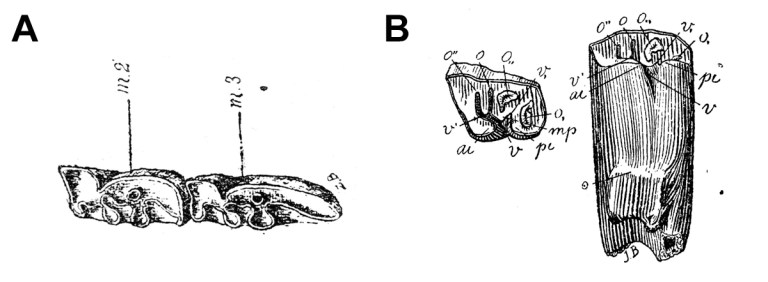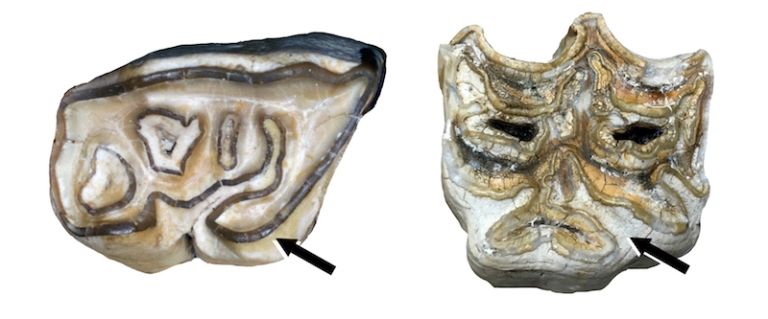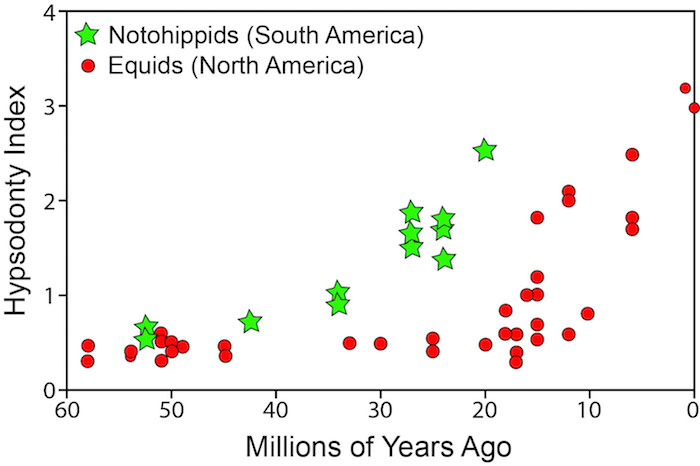A good case could be made that horses are the quintessential ungulates. They are big, fast, smart, and command respect on the wide open plain. There is a reason Ford Motor Company named its famous muscle car the Mustang.
Given the above, one might reasonably expect a similar level of gravitas from Notohippus, South America’s native “horse.” Unfortunately, one would be mistaken. Or, at least, one would probably be mistaken. The fact of the matter is that we know almost nothing about this mammal except what its teeth looked like. But those teeth were enough to convince its namer, Florentino Ameghino, that Notohippus was the ancestor of modern horses rather than an ungulate unique to South America (a notoungulate, to be precise).

Ameghino named Notohippus toxodontoides in 1891 based on only a few lower molars. The teeth were not only hypsodont (high-crowned), but also quite complex, with enamel folds extending inward from the lingual side of the tooth and additional enamel islands (technically termed fossettids) in the middle. Some toxodontid notoungulates have similarly complex teeth, and this resemblance was noted by Ameghino. It is for that reason that he chose the specific epithet toxodontoides. However, he did not think the resemblance between Notohippus and toxodontids was due to close evolutionary relationship, which we now know is indeed the case.
What most impressed Ameghino about the teeth of Notohippus is that they were covered by a thick layer of a tissue known as cement. In mammals with low-crowned (brachydont) teeth, cement is only present in the tooth socket (alveolus), where it helps anchor the tooth’s roots. In hypsodont mammals, cement often extends upward along the sides of the tooth, where it helps reinforce the enamel and provide additional wear resistance. Horses have complex, high-crowned teeth covered by thick cement, whereas early toxodontids generally lack thick cement on their complex, high-crowned teeth. Thus, Ameghino’s confusion can be understood to some extent.

Ameghino originally placed Notohippus (literally the “southern horse”) in the family Protequidae, a clear indication of his belief that it was the ancestor of equids, true horses. (As mentioned in my last post, Ameghino thought most mammals originated in South America.) He subsequently renamed the family Notohippidae, and this name has stuck around to the present day, though it is starting to go out of style. This is because the species traditionally grouped in this family probably do not constitute their own separate branch of the notoungulate family tree. Rather, many of them are very early branches of the toxodontid lineage, and some of them may have diverged even earlier, before toxodontids split from another group of notoungulates known as leontiniids.
It is rather peculiar that Notohippus is the namesake of its family because less is known about this animal than almost any other species in its family; only a few teeth have ever been published in the scientific literature. A 1999 abstract by Ana Ribeiro and Mariano Bond mentioned the discovery of a partial skull of Notohippus, but the specimen has never been described.
Interestingly, Ameghino used the term “Notohippus Beds” (in Spanish or French) to refer to a particular set of outcrops in western Santa Cruz province, Argentina. These early Miocene strata are roughly 19-16 million years old, but their exact age and relationship to other strata are still unclear. They have long been considered to be slightly older than the extremely fossiliferous outcrops along the Atlantic coast of Santa Cruz, but it could be that the two areas partly overlap in age and simply reflect different species living in different regions. (See González-Ruiz and Scillato-Yané 2009 and Bostelmann et al. 2013 for recent discussions of these issues.) Some species are found both in the east and the west of the province, but in other cases, different species of the same genus were living along the coast and near the Andes in the early Miocene. Notohippus stands out in this regard, as no member of its family has ever been identified in eastern outcrops; it is exclusive to western Patagonia, albeit relatively uncommon.

Although Notohippus itself is very poorly known, this is not true of its close relative, Argyrohippus fraterculus, which comes from slightly older (Colhuehuapian; roughly 21-19 million-year-old) outcrops in Patagonia. The thick cement on the teeth of this species is remarkably horse-like, but its upper incisors are also quite reminiscent of Mr. Ed; all three pairs of incisors are large, similar in size, and arranged in a broad arc for cropping vegetation. The wide muzzle of Argyrohippus, combined with a large gap between its incisors and cheek teeth, convey a very horselike gestalt indeed (see above). Ameghino was prescient in his naming of this particular group of notoungulates.

In other respects, Notohippus and Argyrohippus were decidedly unhorselike. These animals were much smaller than a modern horse – probably 15-25 kg, larger than a bobcat but smaller than a sheep – and although no skeletons of either of these animals has ever been described, other notohippids did not have the long limbs and reduced digits so characteristic of modern horses (see Shockey 1997). But these notoungulates did get a leg up on horses in one respect: they evolved hypsodont teeth 10-15 million years earlier than their North American equid counterparts. As regards this key evolutionary adaptation, Notohippus and their kin were indeed thoroughbreds.
References Cited:
- Ameghino, F. 1891. Caracteres diagnósticos de cincuenta especies nuevas de mamíferos fósiles argentinos. Revista Argentina de Historia Natural 1:129-167.
- Ameghino, F. 1904. Recherches de Morphologie philogénétique sur les molaires supérieurs des ongulés. Anales del Museo Nacional de Buenos Aires 9:1-541.
- Bostelmann, E., J. P. Le Roux, A. Vásquez, N. Gutiérrez, J. L. Oyarzún, C. Carreño, T. Torres, R. Otero, A. Llanos, C. M. Fanning, and F. Hervé. 2013. Burdigalian deposits of the Santa Cruz Formation in the Sierra Baguales, Austral (Magallanes) Basin: Age, depositional environment and vertebrate fossils. Andean Geology 40:458-489.
- González-Ruiz, L. R., and G. J. Scillato-Yané. 2009. A new Stegotheriini (Mammalia, Xenarthra, Dasypodidae) from the “Notohippidian” (early Miocene) of Patagonia, Argentina. Neues Jahrbuch für Geologie und Paläontologie – Abhandlungen 252:81-90.
- Ribeiro, A. M., and M. Bond. 1999. Novos materiais de Notohippus toxodontoides Ameghino, 1891 (Notohippidae, Notoungulata) do “Piso Notohipidense“, SW da provincia de Santa Cruz, Argentina. Ameghiniana 36:19-20R.
- Shockey, B. J. 1997. Two new notoungulates (Family Notohippidae) from the Salla Beds of Bolivia (Deseadan: late Oligocene): systematics and functional morphology. Journal of Vertebrate Paleontology 17:584-599.

One thought on “The Original Southern Horse”